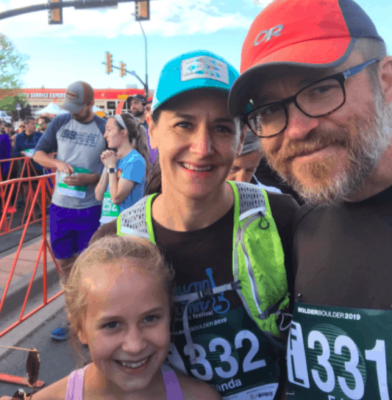“In the COVID world, no one wants to be a diabetic,” says Amanda, RN, BSN, a Colorado-based nurse (RN) care coordinator. “Metabolic awareness can help you survive, and coupled with positive action, can get you out of those risk ranges. I think that instant feedback is the most valuable aspect of continuous glucose monitoring. You need to consciously build an immediate relationship between your lifestyle and its consequences.”
As an RN care coordinator that works with extremely high-risk patients such as individuals with severe cases of diabetes and chronic health issues, Amanda has a unique perspective on the extremes of metabolic dysfunction.
“I’m working with the top 1% of the sickest people, and I focus on health coaching, making sure they have their medications, triage, and so on,” says Amanda. “This category of patients can be incredibly complex. In many cases, it can be difficult to make any lasting positive changes because those conditions have become so severe.”
Amanda aims to help her patients develop an intimate understanding of how they can influence their condition with metabolic awareness and optimization.
“Since many of my patients have continuous glucose monitors (CGMs), I can connect with them on a more personal front, since I went through the process of using a CGM myself,” says Amanda. “They think it’s just a basic tool to check their blood sugar, but when I talk to them from personal experience about how they can change their behaviors by acting on the cause-and-effect relationship right before their eyes, they seem more open to it.” Amanda posits that her patients will get more engaged in the healthcare process by being able to better visualize the connection between the actions they take (like dietary choices or exercise), and immediate reactions (like changes in glucose levels).
“If anyone can make the mindful connections between the supply chain of food, energy, and their overall wellbeing, they’re taking a strong step in changing their lives for the better,” says Amanda. “Being able to connect your subjective feelings to your glucose level readings is a very simple way to accomplish that.”
Since much of Amanda’s responsibilities focus on reducing the complications from chronic illnesses and increasing the quality of life, she spends a lot of time working with patients to help them set goals and make positive lifestyle changes.
“I’m basically in sales, and my product is trying to sell my patients on good lifestyles and good habits,” says Amanda. “I’m trying to show them how if they make some changes, they will feel better. Aging will be better. Everything will be better and easier if you’re doing A-B-C.”
While using Levels, Amanda also gained insights into the power of immediate and personalized data, and has helped her reinforce her healthy habits and prune her negative ones.

Amanda’s Journey to Metabolic Health
“I was really excited about using CGM and, of course, the moment I put it on, I think I checked my blood sugar a hundred times the first day, because I was just so enthralled with the real-time feedback aspect,” says Amanda. “It really made an impact on how I looked at my day-to-day eating and my habits.”
Learn more:
Amanda had always been healthful with eating, but being able to see that instant feedback was a very enlightening moment for her.
“To know how one food makes your blood sugar shoot up versus how that food combined with more fat or protein is really neat,” says Amanda. “I noticed how my thought process changed around food. Every day, I started to think about cause and effect. If I eat this, then this will happen. It starts to stick in the back of your head and you start to think about the consequences of everything you consume.”
“If only more people in the high-risk pre-diabetic range could have access to glucose monitoring and Levels to prevent them from crossing the threshold into the diabetic ranges. It’s just a shame to see people suddenly try to build that awareness only when the problem is staring them right in the face.”
For example, Amanda points to a piece of chocolate-covered honeycomb, and how her experience eating it differed before and after tracking her metabolic response.
“It was basically pure sugar,” laughs Amanda. “It shot my blood sugar up to 180 and it had never gotten that high before. I had another piece of it recently, remembering how it spiked my blood sugar before, and I talked my family into going for a walk after dinner. I didn’t feel that severe of an effect– knowing that I can reduce my spike with small actions like that is very useful.”
Simply being able to confirm her nutritional intuitions with objective data has helped Amanda make more calculated decisions with her meal choices.
“I remember eating a big piece of cheesecake one night, and my blood sugar didn’t really move, which is a stark difference compared to that honeycomb,” says Amanda. Seeing the difference the fat and protein balance made in an otherwise sugary dessert was great to visualize.”
Building Functional Metabolic Awareness
Amanda found herself at a crossroads familiar to many active individuals with a keen interest in nutrition: maintaining a lean figure while consuming the optimal quantity and quality of food to fulfill the energy demons of a highly athletic lifestyle.
“I’m always trying to stay really lean,” says Amanda. “I do functional fitness too, so I try to balance my aerobic exercise with the weightlifting stuff, but if you do too much of either, you have to really focus on the quality and quantity of the food you eat.”
By being able to see her post-workout blood sugar and how it fluctuated throughout the day helped Amanda change the way she ate to maximize her workouts on her most active days.
“My husband, daughter, and I are a very active family,” notes Amanda. “I’m a volunteer for the Colorado Fourteeners initiative, so I climb fourteeners (mountains with an elevation of at least 14,000 feet) on the weekends, and I think Levels has helped me build that awareness to better balance my diet for my most active days and my days that aren’t as active.”
With an average elevation gain of around 5,500 feet, Amanda is likely to burn around 3,000 calories over the span of a few hours. To do so successfully, she must plan her nutrition accordingly.
“Levels has impacted how I cook and the way I plan our meals when we’re out and about,” says Amanda. “I’ve made sure to add more healthy fat to our diet, because I think that was lacking, so it’s not only just benefited me, but also my whole family.”
Her metabolically streamlined approach to nutrition has also cascaded into better sleep.
“I feel like I’m an overall more pleasant person to be around when I’m well-rested– if I’m happier, then everyone else is as well,” laughs Amanda. “I started adding in a high fat snack like peanut butter or almond butter and celery before going to bed and I think I started getting better quality sleep.”
Further, Amanda was able to develop a more granular understanding of what goes on in her body that would otherwise be left to guesswork.
“I have terrible Premenstrual syndrome (PMS),” says Amanda. “Closer to when I’m going to have my period, I had a feeling my blood glucose would be fluctuating a lot– I felt like when it went too high or too low, I would be super irritable. CGM use helped me confirm in real-time that I had more spikes during the week prior. Bad PMS can be related to glucose stores and how your brain uses them, so it was really neat to see that in action.”

Final Thoughts
Today, Amanda has internalized her learnings from her Levels experience and become more mindful of her daily nutrition.
“I found that if I ate a really good protein-packed and fatty snack before bed, I would get better sleep,” says Amanda. “Or, if I exercised and crashed right after, I could tell why. All of these little benefits helped reinforce that body-brain connection that you have when you see what certain foods do to you and how you feel about them.”
By building metabolic awareness early on in life, Amanda posits, people will be able to get a grasp on their metabolic condition and make positive changes before things get too complicated.
“If only more people in the high-risk pre-diabetic range could have access to glucose monitoring and Levels to prevent them from crossing the threshold into the diabetic ranges,” says Amanda. “I bet the majority of the population in the United States is either in the pre-diabetic range or too close for comfort to that range. It’s just a shame to see people suddenly try to build that awareness only when the problem is staring them right in the face.”
“You have to know what you want in life,” implores Amanda. Where do you derive joy from? What matters to you? What does your day-to-day life look like? What do you want it to look like? For example, if you’re 60-years-old and you just got a diabetes diagnosis, the rest of your life is going to be pretty rough if you don’t make some changes. I talk a lot about aging and how much easier the process is with small changes now.”
“Do you want to see your grandkids grow up,” asks Amanda. “If so, do you want to be able to get down on the ground and play with them? You need to have a very personalized vision of what future you want to have because those small changes might be uncomfortable in the short-term, but in the long-term, they’re more than worth it if you set your sights on something that matters to you.”
“You definitely can’t have the same approach for everybody,” says Amanda. “If someone values watching Judge Judy all day, smoking cigarettes, and drinking above all else, we’re likely just going to have a few more conversations, and if not much changes, that’s like to be the end. You need to be ready to change to build a care plan that will work.” Paired with the right tools that offer visibility such as a continuous glucose monitor, large lifestyle changes can become less daunting, especially if they’re staggered in series of small tweaks.









